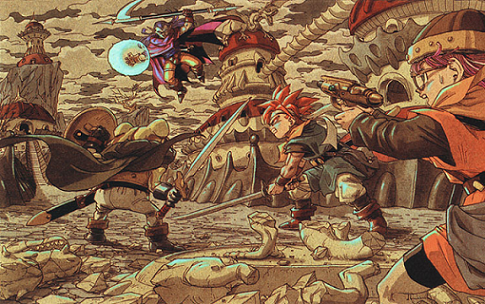
Not too long ago Chrono Trigger was released on the Nintendo DS under the auspices of exposing the classic Snes game to a new generation of gamers. Upon its announced release, game composer Yasunori Mitsuda declared “Finally!...It's still a very deep, very high-quality game even when you play it today. I'm very interested in seeing what kids today think about it when they play it." Its interesting to me that the marketed focus is on providing this classic gaming experience to a new generation of youth. I remember growing up on Chrono Trigger and pretty much spending an entire summer replaying it, trying to get my characters to level 99. I know I’m not the only one. Until this Nintendo DS rerelease, Chrono Trigger was quite rare to find on cartridge, sometimes selling for $200 on eBay, and I retain the notion that console games just aren’t the same when played on an emulator on the computer (you need the couch, tv, controller, and save limitations that only the console offers for maximum chill/fun factor.) However, the DS Chrono Trigger is not the Chrono Trigger of our fathers. Its portable, on (two) small screen(s), the menus are altered, there are added dungeons, new features – oh, yeah – and a new “more accurate” English translation of the original Japanese text.
Recently I have somewhat jokingly discussed with several people as to why the Super Nintendo is the best system of all time. The discussions rarely encountered any empirical evidence to back this up, but maybe there’s something to the claim. Its possible that I’m just displaying symptoms of nostalgia, since the SNES played an integral role in my childhood – however, I think that is too easy of an explanation. I think the “more accurate” translation of Chrono Trigger indicates to a gap that separates today’s systems (I’m looking at you PS3) and the consoles of our youth.

To expand on this, I’m going to draw on my all-time favourite game, Legend of Zelda: A Link to the Past. Released on the Snes in 1992, A Link to the Past has since been adapted to the Game Boy Advance in similar fashion to Chrono Trigger. The game features new dungeons, new features, and a “more accurate” English translation. I noticed this myself as I played the GBA version of the game, as certain text sequences in the game made a hell of a lot more sense than they did when I was a child. Specifically, there is a point when a towns-person refers to the town elder as “Oh, that old guy?” instead of “Oh, the grandpa?”
So maybe this retranslation is a narrative restoration, but why is it that so many English-speaking kids loved that game when many of its plot points barely made any sense? I remember playing many games as a kid, getting confused by the incomplete back-story and thinking I was playing a sequel to a game I had never heard of. I still loved the games though. Even now I’m replaying Illusion of Gaia for the first time since Corey and I beat it in my basement in grade 5, and it barely makes narrative sense.
And this is kind of why I think the Snes is the best. Its limitations as a system force the gamer to employ a great deal of imagination to fully engage with the games. With the insane hardware capabilities today, very little is left to imagination. Solid Snake looks like Solid Snake. Super Mario looks like…a comatose pedophile?

This concept is best illustrated by comparing (or rather contrasting) official game artwork with character sprites from the game. Seeing the variance between what the characters are supposed to look like and what they are represented as indicates to the degree of imagination employed when playing the game. Same goes with bad translations. When games are translated badly, young players may cope with impossibly ambiguous plots with imagination and makeshift narrative connections.
Games today seem to indicate clearly to the gamer exactly what they are capable within the virtual realm. Most games contain some kind of go-to character who is constantly on-hand to provide hints and advice, and to teach gamers exactly what they can and cannot do. When I got stuck in a game back in the day I would spend hours punching walls, slicing pots, and talking to every villager, because I wasn’t quite sure what my character was capable of, and what the game world had to offer. You read the game manual and pretty much thrown into the fray left to your own devices. Now Navi just tells you the answer to the puzzle before you even have a chance to figure it out yourself.
Now one may argue: If limitation is what makes the Snes so good, then what about more limited systems like the Nes?
I think its simply that the Snes has a perfect balance between limitation and capability that is enough to spur the imaginations of the gamer but not fully satisfy the mimesis of the virtual world. That might be a cheap answer…but I pretty much stopped paying attention to this essay as soon as I turned my Snes on.
In Film as Art Rudolf Arnheim essentially argues that cinema's status as an artform depends on its properties that distance it from the real world. I think this notion is pertinent to the Snes. The artistry of the Snes lies in its distance from realistic representation. While the Nes, Atari and other previous systems may seem by this logic more artistic, I somehow think they are less engaging than the Snes.
